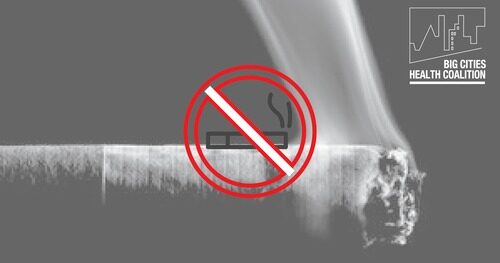Frontline Blog
Innovative Policies to Reduce Tobacco Use in Big Cities
March 2020

Over the years, cigarettes have been the leading cause of preventable death in the United States, accounting for one in five fatalities—more than alcohol, AIDS, car accidents, illegal drugs, murders, and suicides combined. In addition, more than 16 million Americans live with a disease caused by smoking, including stroke, heart disease, cancer, and emphysema. While traditional cigarettes still pose a significant health in the U.S., the market has rapidly changed in the past several years, with a focus on products that appeal to youth and minorities.
In December 2016, a report by the Surgeon General concluded that e-cigarette use by young people is a public health concern, noting use of e-cigarettes has surpassed that of regular cigarettes among those under 18 years old. Two years later, the Surgeon General followed that up with an advisory on e-cigarette use among youth, officially declaring e-cigarette use among youth in the U.S. “an epidemic.
This report noted the nicotine salts that comprise certain popular e-cigarettes allow users to inhale more easily and with less irritation. Certain e-cigarettes available in the U.S. have a nicotine level so high that, in some countries, they are illegal for consumers of any age. In 2019, 5.3 million youth—28% of high school students and 11% of middle school students—were current e-cigarette users; that’s an increase of more than 3 million students since 2017. One out of nine high school seniors (12%) reported that they vaped nicotine nearly daily and the majority of current youth e-cigarette users use flavored products (69%).

In 2009, Congress passed the Family Smoking Prevention and Tobacco Control Act (TCA), which gave the U.S. Food and Drug Administration (FDA) authority to regulate tobacco products using a public health standard. The TCA prohibited certain characterizing flavors, but notably left menthol in the marketplace.
Despite this, the market for flavored tobacco products has been growing, particularly as vaping expands. Even with the Administration’s recent enforcement policy to reduce youth access to flavored e-cigarettes, thousands of flavored products will remain available at over 100,000 locations across the country.
Even with the Administration’s recent enforcement policy to reduce youth access to flavored e-cigarettes, thousands of flavored products will remain available at over 100,000 locations across the country. In the rapidly evolving tobacco market, menthol cigarettes and other tobacco products (smokeless tobacco, cigarillos, and vaping products) are aggressively marketed to appeal to new customers, targeting youth in particular with flavors that play a key role in enticing new users to a lifetime of addiction.
Even as the federal government ramps up its age restrictions, e-cigarette regulations, flavor enforcement, loopholes remain. Big city health departments across the country have filled this gap, using innovative and comprehensive policy levers to reduce tobacco use and save countless lives. The Big Cities Health Coalition is excited to kick off a series of stories (linked below) highlighting the success of local leaders and detailing how these changes were made.


